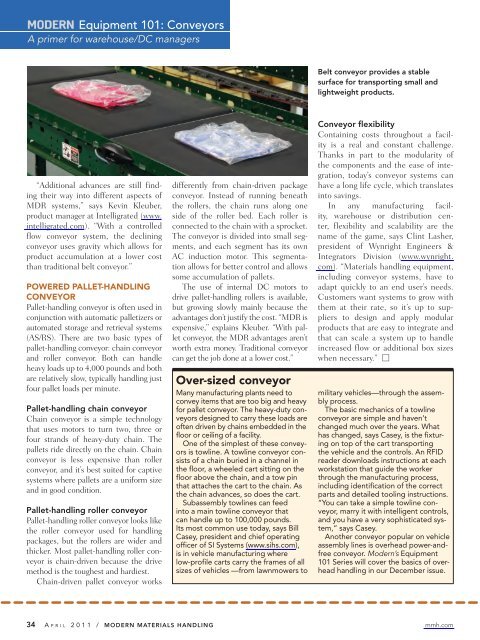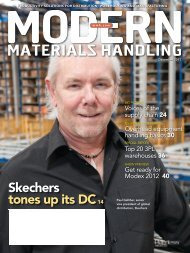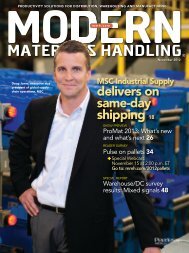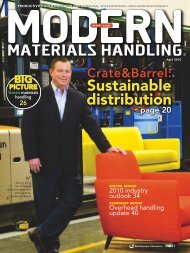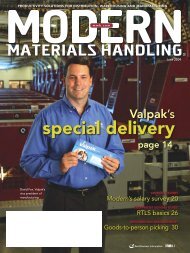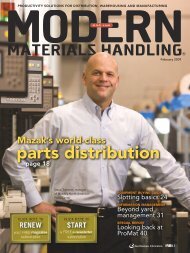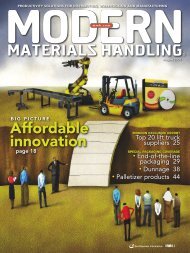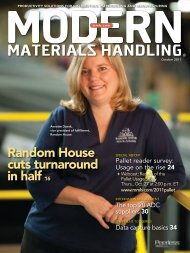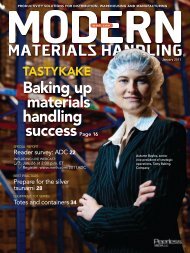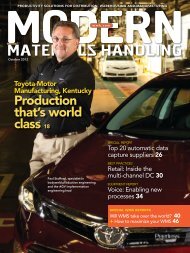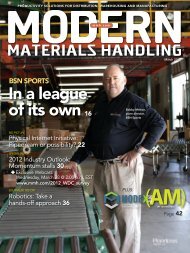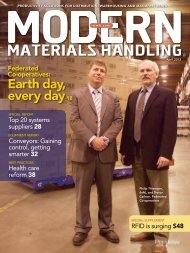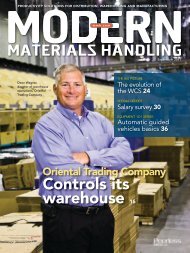Modern Materials Handling - April 2011
Modern Materials Handling - April 2011
Modern Materials Handling - April 2011
You also want an ePaper? Increase the reach of your titles
YUMPU automatically turns print PDFs into web optimized ePapers that Google loves.
modern Equipment 101: ConveyorsA primer for warehouse/DC managersBelt conveyor provides a stablesurface for transporting small andlightweight products.“Additional advances are still findingtheir way into different aspects ofMDR systems,” says Kevin Kleuber,product manager at Intelligrated (www.intelligrated.com). “With a controlledflow conveyor system, the decliningconveyor uses gravity which allows forproduct accumulation at a lower costthan traditional belt conveyor.”POWERED PALLET-HANDLINGCONVEYORPallet-handling conveyor is often used inconjunction with automatic palletizers orautomated storage and retrieval systems(AS/RS). There are two basic types ofpallet-handling conveyor: chain conveyorand roller conveyor. Both can handleheavy loads up to 4,000 pounds and bothare relatively slow, typically handling justfour pallet loads per minute.Pallet-handling chain conveyorChain conveyor is a simple technologythat uses motors to turn two, three orfour strands of heavy-duty chain. Thepallets ride directly on the chain. Chainconveyor is less expensive than rollerconveyor, and it’s best suited for captivesystems where pallets are a uniform sizeand in good condition.Pallet-handling roller conveyorPallet-handling roller conveyor looks likethe roller conveyor used for handlingpackages, but the rollers are wider andthicker. Most pallet-handling roller conveyoris chain-driven because the drivemethod is the toughest and hardiest.Chain-driven pallet conveyor worksdifferently from chain-driven packageconveyor. Instead of running beneaththe rollers, the chain runs along oneside of the roller bed. Each roller isconnected to the chain with a sprocket.The conveyor is divided into small segments,and each segment has its ownAC induction motor. This segmentationallows for better control and allowssome accumulation of pallets.The use of internal DC motors todrive pallet-handling rollers is available,but growing slowly mainly because theadvantages don’t justify the cost. “MDR isexpensive,” explains Kleuber. “With palletconveyor, the MDR advantages aren’tworth extra money. Traditional conveyorcan get the job done at a lower cost.”Over-sized conveyorMany manufacturing plants need toconvey items that are too big and heavyfor pallet conveyor. The heavy-duty conveyorsdesigned to carry these loads areoften driven by chains embedded in thefloor or ceiling of a facility.One of the simplest of these conveyorsis towline. A towline conveyor consistsof a chain buried in a channel inthe floor, a wheeled cart sitting on thefloor above the chain, and a tow pinthat attaches the cart to the chain. Asthe chain advances, so does the cart.Subassembly towlines can feedinto a main towline conveyor thatcan handle up to 100,000 pounds.Its most common use today, says BillCasey, president and chief operatingofficer of SI Systems (www.sihs.com),is in vehicle manufacturing wherelow-profile carts carry the frames of allsizes of vehicles —from lawnmowers toConveyor flexibilityContaining costs throughout a facilityis a real and constant challenge.Thanks in part to the modularity ofthe components and the ease of integration,today’s conveyor systems canhave a long life cycle, which translatesinto savings.In any manufacturing facility,warehouse or distribution center,flexibility and scalability are thename of the game, says Clint Lasher,president of Wynright Engineers &Integrators Division (www.wynright.com). “<strong>Materials</strong> handling equipment,including conveyor systems, have toadapt quickly to an end user’s needs.Customers want systems to grow withthem at their rate, so it’s up to suppliersto design and apply modularproducts that are easy to integrate andthat can scale a system up to handleincreased flow or additional box sizeswhen necessary.” Mmilitary vehicles —through the assemblyprocess.The basic mechanics of a towlineconveyor are simple and haven’tchanged much over the years. Whathas changed, says Casey, is the fixturingon top of the cart transportingthe vehicle and the controls. An RFIDreader downloads instructions at eachworkstation that guide the workerthrough the manufacturing process,including identification of the correctparts and detailed tooling instructions.“You can take a simple towline conveyor,marry it with intelligent controls,and you have a very sophisticated system,”says Casey.Another conveyor popular on vehicleassembly lines is overhead power-andfreeconveyor. <strong>Modern</strong>’s Equipment101 Series will cover the basics of overheadhandling in our December issue.34 A p r i l 2 0 1 1 / <strong>Modern</strong> <strong>Materials</strong> <strong>Handling</strong> mmh.com


